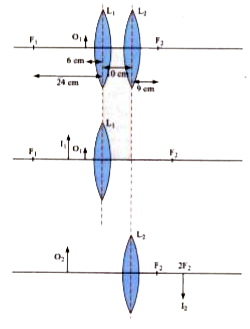Figure shows an object AB placed in front of two thin coaxial lenses 1 and 2 with focal lengths 24 cm and 9.0 cm, respectively. The object is 6.0 cm from the lens/and the lens separation is . Where does the system of two lenses produce an image of the object AB?

The correct Answer is:A
For first lens
From the lens formula
For second lens
Again, using lens formula,
Final image will be formed at 18 cm to the right of scond lens.
Topper's Solved these Questions
Similar Questions
The given figure shows the object O1 that is placed in front of two thin symmetrical coaxial lenses 1 and2, with focal lengths f1=+24cmandf2=+9c, respectively and with lens separation L = 10 cm. The seed is 6 cm from lens 1. Where does the system of two lenses produce an image of the speed ?

View SolutionAn object of height 1 cm is placed in front of a concave lens of focal length 40cm . If the object distance is 60 cm , find the position and height of the image .
View Solution
Knowledge Check
The image distance of an object placed 10 cm in front of a thin lens of focal length +5 cm is
A6.5 cmB8.0 cmC9.5 cmD10.0 cmAn object is placed 25 cm in front of a concave lens of focal length 25 cm. The position of images is
A- 10 cmB+ 10 cmC- 12 . 5 cmD12 . 5 cmAn object placed 10 cm in front of a convex lens of focal
length 15 cm. The image produced will beAa Real and magnifiedBb Virtual and magnifiedCc Virtual and reduced in sizeDd Real and reduced in size
An object of height 4 cm is placed in front of a concave lens of focal length 40 cm. If the object distance is 60 cm, find the position and height of the image.
View SolutionA convex lens of focal length 15 cm is placed on a plane mirror. An object is placed at 30 cm from the lens. The image is
View SolutionAn object is placed in front of a thin convex lens of focal length 30cmand a plane mirror is placed15cmbehind the lens.If the final image of the object coincides with the object the distance of the object from the lens is
View SolutionAn object is placed 12 cm from a convex lens whose focal length is 10cm. The image must be:
View SolutionAn object is placed in front of two convex lenses one by one at a distance u from the lens. The focal lengths of the lenses are 30 cm and 15 cm respectively. If the size of image formed in the two cases is same, then u is
View Solution